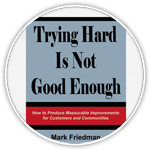America has a set of creation myths. One of these is that we are a melting pot. Immigrants come to America and blend their unique contributions into an homogeneous broth that is an ever evolving American culture. In this metaphor, children and grandchildren of first gene ration immigrants gradually lose their cultural identity and become more or less indistinguishably “American.” If this idea was ever true in America, it is not true today. While we may share a form of American identity, we also have separate cultural identities. America is not a pot of melted cultures and but rather a place of coexisting cultures, each vitally alive and unmelted.
The good part of the melting pot myth was that, in theory, everyone was welcome, even the tired and the poor. Each would enrich American culture. Each would embrace the idea of a common identity. Each would adopt and eventually achieve the “American dream” of freedom and prosperity.
The bad part of the melting pot was its rationalization of racism and intolerance. The melting pot metaphor writes off racism as a temporary transition period for minorities. As each culture is melted into the American culture, racism and prejudice fade away for that particular group. But history shows that immigrants and other cultural minorities have not been welcomed. And racism and intolerance are not temporary, but rather chronic, conditions of American society.
The bad part of the melting pot was its rationalization of racism and intolerance. The melting pot metaphor writes off racism as a temporary transition period for minorities. As each culture is melted into the American culture, racism and prejudice fade away for that particular group. But history shows that immigrants and other cultural minorities have not been welcomed. And racism and intolerance are not temporary, but rather chronic, conditions of American society.
The melting pot metaphor just doesn’t work. Many Americans are not immigrants at all. Slavery is not immigration. Border changes don’t produce immigrants. And Native Americans lived here first. The imagined America of wave after wave of immigrants is in fact an America of hundreds of simultaneous and continuous immigrations on top of already troubled relationships between races, classes, ethnic groups, religious groups, sexual groups and political groups. Past approaches to “solving the problem” fail in the face of this complexity. The challenge is not, and never was, how to absorb the latest wave of immigrants. The challenge is how to live together as a healthy multi-cultural society.
We need an open, blame free discussion of what it would take to achieve a healthy multicultural society. We must find a way to have this discussion that treats it as a positive vision to be achieved not a negative problem to be solved. There are methods that can be used to do this. A healthy multi-cultural society is an end condition, or “result” we can all support, just as we can all support the notion of “children ready for school” or a “clean environment.” We can ask what a healthy multi-cultural society would look like and how we could measure the extent to which we now live in such a society. There are some obvious ways to measure this, including rates of hate crimes and diversity of elected officials, and there are many other measures that could be developed, like the percent of non-white Americans who feel their culture is respected. We can create trend lines for these indicators to see if things are getting better or worse. We can study the story behind these conditions. We can name and engage the partners who have a role to play in doing better. We can think about what it would take to do better. And we can agree on concrete actions we can take to turn things around.
This conversation from results to action can be held with diverse groups in different settings. It can be done neighborhood by neighborhood and city by city. And it can be done with less animosity than the current “problem of racism” discussions that raise tensions and mostly fail to move us forward.
The dream of a healthy multi-cultural society comes from our visionaries of the past, including King and Chavez. A less talked about part of that dream is about how to structure the conversation that leads to change. We need to replace the melting pot image of the 19th and 20th Centuries with the vision of a healthy multi-cultural society in the 21st Century. And we need to frame the discussion in terms of positive quality of life conditions for our country that we can all work together to achieve.



